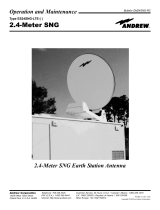
Safety precautions:
Read this manual carefully and become familiar with your satellite antenna. Understand its applications, its
limitations and any hazards involved. Failure to follow all instructions listed below may result in electric shock,
fire and/or serious injury. Maxview declines all responsibility in the event of incident or accident if they are due
to a non observation of the installation instructions or the way the product is used.
No modifications are permissible to the Antenna Unit or Handle Assembly
Installation
• Installation should be carried out by a competent person.
• Take care when working at heights keeping work area clean and tidy to avoid trip hazards
• Use creeper boards where necessary to ensure roof construction can support your weight
• Use a recommended adhesive from page 4 to bond the antenna unit to vehicle roof and follow the
manufacturer’s instructions during application
• Do not travel until adhesive has cured noting that curing times vary with weather conditions
• Power tools should be used in accordance with manufacturer’s instructions
• All electrical work should be carried out by a competent person. If in doubt seek advice from a qualified
electrician
Operation
• Before starting your journey check that antenna is in the park position
• The maximum speed of vehicle with antenna mounted on roof is 81mph (130km/h)
• Never operate the antenna if someone is in close proximity of the antenna
• If high winds or electrical storms are anticipated lower antenna to park position
• Do not allow children to operate the antenna unit
• Do not operate the Crank Up with snow or ice on the antenna
Servicing
• If in the event that you do experience a problem with the system call Maxview Customer Service
+44 (0)1553 811000
• Any inspection or repair must be carried out by Maxview or an appointed representative of the manufacturer
• No regular maintenance required on the system
• Do not remove cover on Antenna
• Do not use solvent or abrasive cleaning agents on the system
• Use a suitable mild detergent to clean the Antenna Unit
• Do not pressure wash the Antenna Unit
• Check the Antenna Unit fixings for mechanical integrity at least once a year
Page 3






















